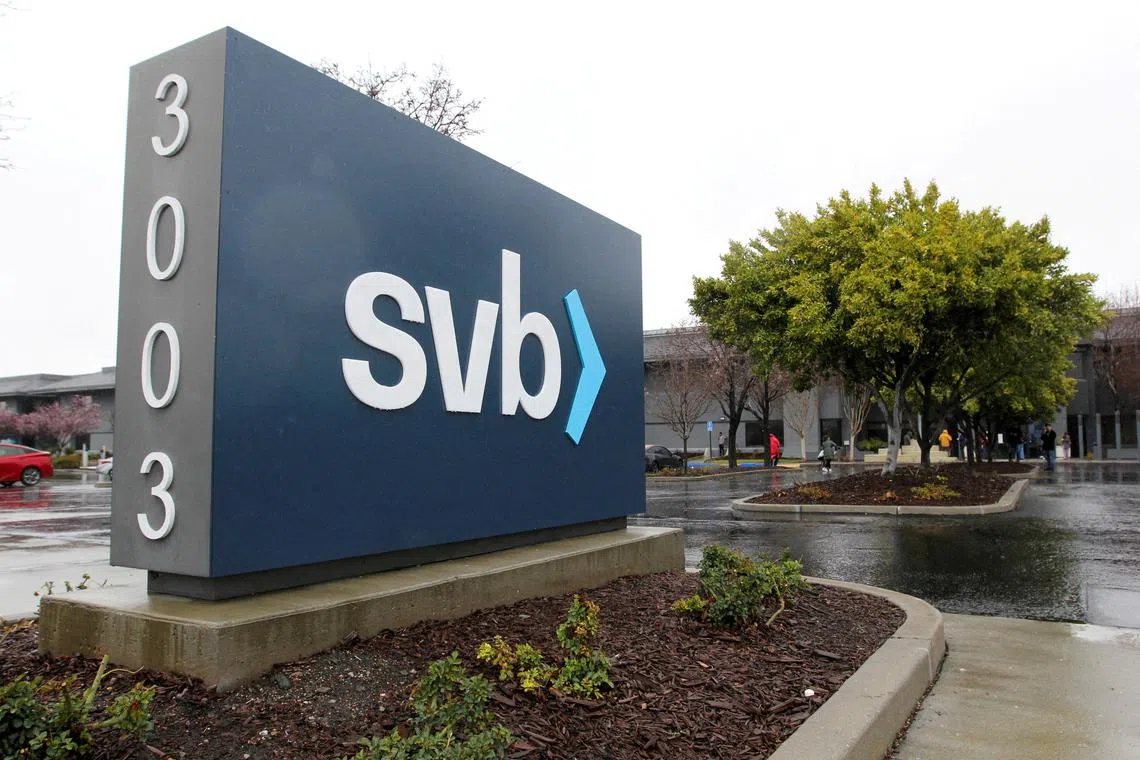US bank failure exposes lurking systemic risk of tech’s trillion-dollar money machine
Sign up now: Get ST's newsletters delivered to your inbox

Silicon Valley Bank billed itself as a one-stop shop for tech visionaries.
PHOTO: REUTERS
Follow topic:
San Francisco – The collapse of Silicon Valley Bank (SVB)
SVB billed itself as a one-stop shop for tech visionaries. Its tactics to bundle client services were deemed aggressive by some, but it was hard to argue with the results: Business with 44 per cent of VC-backed technology and healthcare companies that went public last year, and overall explosive growth during boom times.
In so doing, it created massive counterparty risk – a single point of failure that could imperil the sprawling financial ecosystem that backs America’s next big ideas.
Private equity firms including Vista Equity Partners, Insight Partners and Thoma Bravo have dozens of portfolio companies that banked with SVB. It was the institution of choice for start-ups backed by the region’s most prominent venture firms, like Sequoia Capital and Andreessen Horowitz. It also provided services to Roku and other public companies long after their initial public offerings.
It is a startling wake-up call to regulators after largely standing by as the shadow banking system ballooned in the wake of the global financial crisis. Private equity firms invested more than US$6 trillion (S$8 trillion) in the United States economy in the 10 years to 2021 and employed more than 11.7 million Americans. VC money more than quadrupled to about US$1 trillion from 2007 to 2021, and VC-backed companies have 3.8 million workers – a 960 per cent increase from 1990.
US financial regulators laid out a plan on Sunday to protect depositors’ funds after SVB’s demise.
It allows banks to place Treasuries (US government bonds), which have declined sharply in value over the past year, at the Fed and receive face value back in the form of a one-year loan. It was large unrealised losses on such securities, combined with unstable deposits, that doomed SVB.
“Glad we did not have to learn the hard way, but this is still a reminder of the dangers when we become too dependent on a single point of failure,” said Mr Darren Eng, a venture capital adviser and executive director of Los Angeles’ venture association. “The ecosystem should not be beholden to just one bank.”
Vast reach
SVB’s vast reach was laid bare to Mr Joshua Frost, the US Treasury’s assistant secretary for financial markets, as he addressed a virtual audience of almost 1,000 venture capitalists and their portfolio companies last Friday evening.
During a members-only Zoom call, representatives of lobbying group National Venture Capital Association (NVCA) threw question after question at Mr Frost, who would later that evening speak to FDIC officials. They implored him to consider the industry’s view when officials crafted a response.
“The magnitude of what this industry is responsible for, and on behalf of the country – this is significant,” said NVCA president Bobby Franklin. “This is where the innovation happens.”
The same day, some 20 private equity chief financial officers and executives with exposure to SVB jumped on a call. Some said that if it became clear deposits were not secure at smaller institutions like SVB, they would stop parking assets in them altogether, said a person briefed on the call.
Meanwhile, institutional investors were rushing to make sure they were not sending money into SVB’s black hole.
In the back offices of some of the nation’s biggest public pension plans, employees on Friday were checking that funds for capital calls were not being wired to accounts tied to SVB, according to a person familiar with the matter.
“SVB would provide venture debt for companies that sometimes don’t have revenues or millions in revenue at a very good price,” said Mr Jai Das, co-founder of Sapphire Ventures. “There was a lot of trust involved.”
“The fates of thousands of small technology companies and the vitality of the start-up economy will be back in the hands of strangers,” Sequoia partner Michael Moritz wrote. “And the US will be all the poorer.”
SVB was not the only financial institution that the tech industry patronised, of course, but it was a clear leader in the market, so much so that banking there was something of a badge of honour among venture capitalists.
Its collapse leaves a void in the industry that in the immediate aftermath will likely be filled by multiple banks.
“What would be best for the ecosystem is for a half a dozen banks all partnering with early-stage tech entrepreneurs and investors,” said Mr Scott Jacobson, a managing director of Madrona Venture Group. BLOOMBERG

